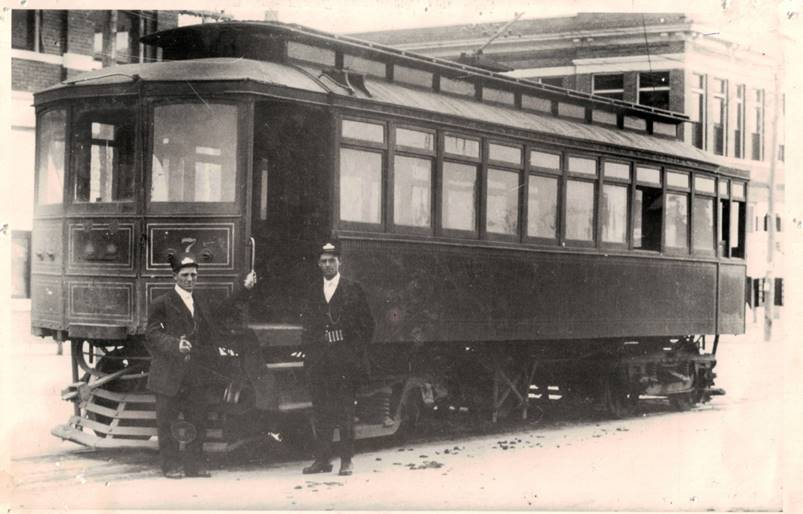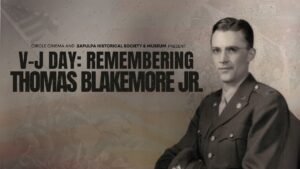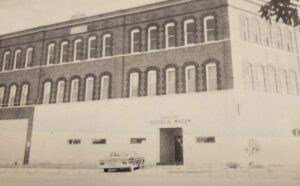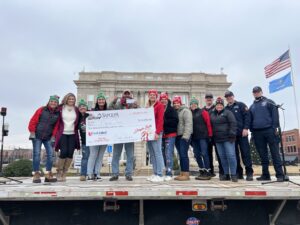By Cecil Cloud
The war years had brought new wealth to the oil fields. The end of the war and the tumultuous post-war years brought new opportunities. New ownership of the interurban line brought new ambitions. Tom Slick and his partners were involved in railroad and interurban operations throughout Northeast Oklahoma. J.A. Frates Sr. and Jr. were vice presidents of the Frisco, and in-laws of Mr. Slick. They were building the Oklahoma and Southwestern in the Little Deep Fork Valley southwest of Sapulpa. They were also invested in the Sapulpa and Oilfields railroad, operating through western Creek County from the Frisco at Depew to the boomtown of Shamrock. The partners also owned the Miami and Mineral Belt Railway—The Ore Line—in Northeast Oklahoma. The Sapulpa and Interurban was to be tied into these operations.

On October 21st, 1921, the Oklahoma Union and the Oklahoma and Southwestern were consolidated. Slick’s plans for the O&SW were grand, connecting Bristow to Okmulgee and Henryetta, then heading southwest to connect with the Fort Smith and Western at Okemah.
The interurban had not been associated with an amusement park since Orcutt Park closed in 1917. Electric Park in Tulsa opened around 1920. Built along the interurban right-of-way in Red Fork, the park featured a roller coaster named “Zingo”. This large wooden coaster was built in the early 1920s and operated into 1937. The Crystal City name came in 1928, and the park continued under that name until it closed in 1948. The Casa Loma Ballroom and Terrace was the last holdout of the park, lingering into 1950. In 1958 the area was redeveloped into the Crystal City Shopping Center.
The ride between the Sapulpa and Tulsa took about 45 minutes on the Interurban. The double-truck interurban cars carried passengers and express freight between the two downtowns. Passengers could transfer to city cars at either end of the run.
About 1923, the Oklahoma Union Railroad was building south through Mounds, toward a projected junction with the Oklahoma and Southwestern at Tolon. According to an old O&SW timetable, Tolon was between Edna and Nuyaka. Interurban service to Mounds commenced in 1924. Service south of Mounds was by bus until the Mounds line was abandoned in 1928. Imagine riding an un-airconditioned bus on the unpaved, dusty roads of the day.
On May 8, 1923, a dispatcher’s error lead to two interurban cars colliding in Red Fork, near the swimming pool at Electric Park. The all-steel construction of the interurban cars prevented death and serious injury, but the passengers were shaken and the noise of the collision was heard over a mile away. This was the second major rail accident at Red Fork, which was also the site of a notorious train robbery in the 1890s.
A 1924 Oklahoma and Southwestern Railway/Miami Mineral Belt/Oklahoma Union Rwy/Oil Fields Short Line R.R. timetable reprinted in The Sapulpa and Tulsa Trolley Connection lists T.B. Slick as President, Mr. J.A. Frates as Vice-President, Mr. C. F. Urschel of Oklahoma City as Assistant to President, and O.M. Sewell as Assistant to Vice-President. Other officers include J.A. Frates, Jr., as Secretary and Treasurer, J.T.Crow as General Agent agent of the O.U. Rwy. at Sapulpa, and R.V. Miller as General Manager, with E.C. Van Valkenburg as Assistant to General Manager.
Messrs. Frates, Senior and Junior, were Vice Presidents of the Frisco and investors in a number of branch lines associated with the Frisco. Urschel, an oil man, was married to Flored Slick, the sister of Thomas B. Slick, the “King of the Wildcatters”. Thomas B. Slick was married to Berenice, the daughter of Frates, Sr.; she became director of the Oklahoma Union after the 1929 reorganization. Judge Franklin Kenamer of Tulsa appointed J.A. Frates, Sr. as receiver of the line.
By 1928, the Kiefer to Mounds Interurban line was abandoned. Company resources were being diverted toward the Tulsa market. The Oklahoma and Southwestern line, stalled at Nuyaka, was bankrupt in 1929. The Oklahoma Union, which had been conducting joint operations with the Midland Valley Kiefer Branch through a connection at the Crosbie plant, was bankrupt in 1929.
The Tulsa Fairgrounds line of the Oklahoma Union was abandoned by December 1931.
The Oklahoma and Southwestern was abandoned in 1930. Thomas B. Slick died of a stroke following emergency surgery on August 16, 1930. Flored (Slick) Urschel died in 1931. Berenice Slick, once a Director of the Oklahoma Union, would go on to marry Charles F. Urschel, her former business partner.
The end of passenger operations on the Oklahoma Union railway came on August 12th and 13th of 1933. The last city car run terminated in Tulsa at 12:45am on the 13th; the last interurban run terminated at 1 a.m. on that date. Freight operations continued.
On July 22, 1933, in Oklahoma City, George “Machine Gun” Kelly and Albert Bates burst into the Urschel home during a bridge game. The gunmen took Urschel and Walter R. Jarrett hostage. The kidnappers drove their victims to a point twelve miles from the city. Having identified Urschel, they released Jarrett. Urschel was taken to a farmhouse near Paradise, Texas. He was released on July 30 after a relative paid a ransom with documented bills. Due to bad publicity from the Lindbergh kidnapping, J. Edgar Hoover pulled Special Agent Gus Jones, a former Texas Ranger, off the Kansas City Massacre case to pursue the Urschel kidnappers. When Kelly was tracked down by federal agents in Memphis, Tennessee, he was reported to have said, “You’ll never take me alive, G-Men,” coining a gangster movie cliché. After the kidnapping, Mr. Urschel and Berenice relocated to San Antonio, TX, where they operated the Slick Oil Company. Mr. Urschel lived until 1970.
The O&SW was gone by 1930. The downtown loop in Sapulpa was taken up by 1931. The Midland Valley abandoned the Kiefer line and the branch to Glenpool by 1936. The Midland Valley came under control of the Muskogee Company by 1938. The Sapulpa and Oilfield branch of the Frisco continued service to Shamrock and Hill Camp until 1957.
On September 9, 1933, the Oklahoma Union Salvage leased the line and some equipment to the newly organized “Union Railway Company”. On January 19, 1934, this became the “Sapulpa Union Railway.” On April 27, 1934, George F. Collins of Sapulpa terminated the lease and bought the property. This was the beginning of a long-term association between the Collins family and the line.
The war brought a brief reprieve for other Oklahoma electric lines. In Sand Springs, the Sand Springs Line kept up passenger service into downtown Tulsa until 1955. The Oklahoma Railway in Oklahoma City experienced a last boom, handling wartime traffic to the airfield in Norman; the last car to Norman ran in 1947. The Union Electric Line, operating north from Nowata into Kansas, handled passenger service until 1947.
The Tulsa newspapers ran articles in 1942 suggesting a return to passenger service on the line but nothing came of it. On January 1, 1943, the line received a new and enduring name: The Tulsa-Sapulpa Union Railway. The TSU continued as an electric freight line operating between Tulsa and Sapulpa. The big customer on the line was Liberty Glass, another Collins business.
The TSU was dieselized in 1960 and passed into a different chapter of history. Traces of the Interurban are still discernable. The vibration you feel in your left front wheel as you drive north on Main in front of the Post Office is a reminder of the South Main track. Similar traces turn up on West Lee and South Independence, courtesy of the Fife Place line. Parts of the Fairgrounds Line in Tulsa still show up in the streets north and west of the Fairgrounds. Other sections of surviving right-of-way are on private property. Portions of the Kiefer line are still visible in Kelley Lane Park. Glenpool Street in Sapulpa is another section of the line. It is just possible to locate one portion of the line to Mounds along Alternate 75 south of Kiefer. The TSU line from the current shop on E. Dewey to Red Fork is the operating legacy of the Oklahoma Union. Nickel Creek bridge is the icon of the OURR and TSU. Onion Creek bridge can be seen from State Highway 66 on a good day. The powerhouse still stands at the rear of the old OG&E garage property near Elm and Hobson.
Wimpy’s Diner was the best-known relic of the Sapulpa and Interurban. Whitney Martin bought the car in 1932. After the Diner closed in 1972 the property was sold to Seller’s John Deere and served that business for several years. The new owners gradually built a larger structure around the trolley, then disassembled the car body. The Sapulpa Historical Society Museum includes a display of Wimpy’s memorabilia. The survivors of the car roster are:
“Maggie”: First repurposed as a gas station, then moved behind a home in central Sapulpa, and then restored by volunteers with Sapulpa Trolley and Railroad in the 1990s, this single truck Birney Car is on display at 701 E. Dewey.
Interurban car 202, a two truck, 1939 product of the Cincinnati Car company, came to the Oklahoma Union from the Cincinnati and Lake Erie. Sold to Borg Compressed Steel as scrap in 1955, it was sold to the Seashore Trolley Museum of Kennebunkport, Maine in 1974. Restored to Cincinnati and Lake Erie colors, it is still operating.
If you would like to ride a trolley, the Fort Smith Trolley Museum operates a restored Birney car over a loop of track connecting the Fort Smith Historical Site on Garrison Avenue with the Fort Smith National Cemetery. Judge Isaac Parker’s grave is visible from a stop on this trip. The Trolley Museum collection includes several other trolley cars in various stages of restoration, as well as a Frisco steam engine. The Museum is located at 100 S. 4th Street in Fort Smith visit their website at fstm.org for hours of operation and other information. The well-maintained Frisco Station is next door to the Historic Site and is the Home of The U.S. Marshalls Museum.









